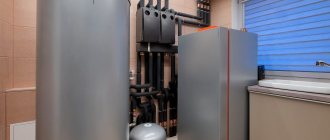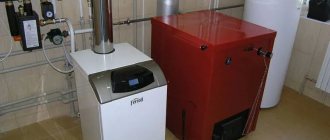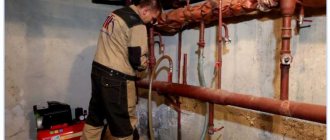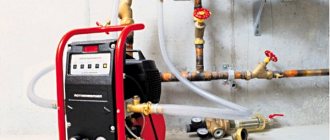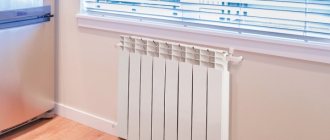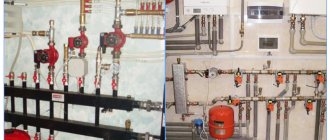The vast majority of heating systems for private houses are built according to a scheme in which the boiler is heated by a thermal agent, which releases energy into radiators or “warm floor” pipes.
If the coolant for the heating system meets the operating conditions, the service life of heating devices increases and emergency situations are eliminated. Water or antifreeze of various chemical compositions are used as a coolant. The property owner needs to objectively evaluate what is most suitable for use.
Coolant requirements
The safety and efficiency of using a heating agent depends on its consumer qualities and technical data.
Coolant requirements:
- high thermal capacity – the ability to quickly heat up and transfer heat;
- neutrality or minimal chemical reactions with equipment materials;
- a wide range of operating temperatures at which the state of aggregation does not change;
- no scale formation during prolonged exposure to high temperatures;
- stability of chemical composition;
- constancy of fluidity and thermal capacity for the entire period of operation declared by the manufacturer;
- safety for users – the absence of toxic, flammable, radioactive and explosive substances in the composition or the impossibility of their formation.
There are subtleties of choice depending on the equipment used. For example, distilled water and most of the range of antifreezes and antifreezes cannot be used for electrode boilers.
Filling technology: where to supply coolant
The necessary means are a container and a pump that creates the required pressure of the coolant liquid. Submersible type “Gnome” or “Kid” are quite suitable (popular with gardeners who use them for watering areas located above the levels of reservoirs). There is evidence of successful filling of closed systems using hand pumps - from those used for spraying protective solutions on garden crops, to specialized hand pumps used for pumping motor fuels or liquid chemicals from drums. Any heating circuit can be successfully filled by monitoring the pressure using a pressure gauge.
Filling the system with antifreeze using a submersible vibration pump.
The first step is to select the fluid entry point. If the pressure created by the pump raises the liquid to the top of the system, it should be connected at the lowest point of the boiler room - the coolant make-up pipe, cut into the “return” in front of the boiler. In addition to the make-up inlet, a structurally separate drain outlet is required (two different system components). The first is equipped with a valve (ball valve) and a check valve, the second - only with a valve (ball valve). If the lowest point of the system is the water drain fitting from the boiler, then you can drain/fill the system with water through it. Since a check valve is not installed behind the boiler drain (behind the drain at all), any shutdown of the pump will cause the pumped liquid to leak out - you need to quickly turn off the tap in front of the fitting.
Design of a typical drain/recharge unit.
Is ordinary water sufficient as a coolant?
Water is one of the best coolants for a country house system.
| Advantages | Flaws |
| High heat capacity, better only with distilled water | Freezing at temperatures below 0°C, which does not allow use in equipment operating intermittently and will require draining during prolonged interruptions in the coolant supply |
| Everywhere Availability | Allows a high degree of oxygen saturation, which accelerates corrosion |
| Low cost - there are practically no costs for filling the system | Accelerated formation of scale and build-up when using water from external sources (wells, boreholes), as well as with poor quality water treatment |
| Stable fluidity and heat capacity at different temperatures | |
| Safety – does not emit toxic substances, does not burn, does not explode |
In most cases, deficiencies can be eliminated using simple water treatment methods.
Technical requirements for water for use in the heating system
The exact requirements for water quality for centralized systems (which can also be followed by owners of private houses) are determined by Order of the State Construction Committee of the Russian Federation No. 285 dated December 13, 2000.
The document defines the maximum values:
- free carbonic acid content – 0;
- pH (acidity level) – 8.3-9.0 for open heating systems, 8.3-9.5 for closed ones;
- iron compounds mg/kg no more than 0.3 for open and 0.5 for closed types of heating construction;
- dissolved oxygen – 20 mcg/kg;
- suspended substances – 5 mg/kg;
- petroleum products – 0.3 mg/kg for open and 1 mg/kg for closed systems.
Measurements are carried out 2 times a year on centralized networks and it is advisable to do this before the start of the heating season in private homes.
The intensity of corrosion can be understood by changes in the content of carbon dioxide, dissolved oxygen and the amount of iron compounds. Indirect signs of deposits are increasing values of calcium and total hardness, bicarbonate and total alkalinity, as well as the content of iron sulfates.
When it is not possible to obtain clean coolant (for example, from a well), you can purchase water already prepared for the heating system. The asking price is 200-300 rubles. for 10 l. coolant.
How to improve important water indicators
Some characteristics of coolant water can be improved at home.
Available methods:
- boiling, freezing, distillation, settling;
- use of mechanical filters;
- use of filters with inhibitors (neutralizers);
- adding chemical reagents;
- catalytic oxidation of iron and its removal into sediment;
- deaeration.
- treatment with electromagnetic waves or a permanent magnet at a coolant temperature of up to 70°C.
Important! Soft, demineralized water with a pH below 6.5 is harmful to heating systems with steel components (pipes, expansion tank). Calcium salts reduce the intensity of acid reactions that accelerate the appearance of rust.
Types of water filters
Not all types of filters sold are effective. The use of some types is irrational in heating systems - while improving performance and making water suitable for drinking, they do not improve the qualities required in heating systems.
The most affordable product for home water treatment is a polyphosphate filter (softener) , costing from 600 rubles. The price of a portion of backfill starts from 200 rubles.
Simplified connection diagram for a softening filter.
The operating principle is based on “enveloping” hardness salts with a phosphate film, which prevents the formation of scale.
The filter is installed so that water from the water supply or well enters the heating system. One fill is enough to soften up to 100 tons of water, or for a year of use by a family of 3-5 people.
Attention! After passing through the polyphosphate filter, the water becomes unfit for drinking.
Magnetic filters are installed in front of the boiler. Passing through the device, the water briefly changes its properties and sludge is formed in the heating zone, which is not deposited on the walls of the heating devices. The sediment is retained by the filter and removed by blowing. Cost - from 1,700 for domestic and up to 10,000 rubles. for imported products.
Reverse osmosis is an effective purification method. Using the device only to recharge the heating system is ineffective and, considering the price (from 5,000 rubles), expensive. In practice, water is purified by reverse osmosis and pumped into the system through a make-up tap.
Mechanical filters with membranes or backfill are used to remove sand, clay, zooplankton and organic compounds. Cost – from 900 rubles, price of cartridges – from 150 rubles.
Important! Mechanical filters do not soften water, but only purify it from suspended impurities.
Boiler water is not antifreeze, freezes at 0°C and cannot be used in houses with periodically switched off heating.
How to choose a water softener for a gas boiler and extend the life of the heat exchanger
How to prepare a heating system for filling?
Before filling the heating system with distilled water, you should prepare. This means the following activities:
- Drain the old coolant . Turn off the heating boiler and wait until the temperature drops to room temperature. Then open the drain valve located at the bottom of the circuit and drain the water into a container for later disposal. After the system is completely emptied, open the Mayevsky valve (located at the top) to stabilize the pressure in the pipes.
- Rinse the circuit . This is required to remove all accumulated debris from inside. Why connect a pump, which is used to pump flush water. For these purposes, you can use tap water. Sometimes one cycle is not enough to completely clean the system. The outlet water must be clean.
- The equipment is pressed . Allows you to test the system for leaks before filling it with coolant. It is necessary to create internal high pressure by pumping air or coolant. To do this you will need a mechanical or electric pump.
- Correct defects . Leaks discovered during pressing must be eliminated. If leaks are detected at the joints, then replace the seal. When a pipe leaks, the damaged section is replaced.
- Check the package . When the heating system is closed, you will need to make sure that there are safety devices in place before filling it. First of all, this is a Mayevsky tap, bypasses, a thermometer and a pressure gauge. The absence of something can lead to problems in the operation of the equipment in the future.
Important! Before filling the coolant, it is necessary to flush the system, even if it is just installed.
Types of specially prepared compounds - antifreeze
Antifreeze is not drained during long-term power outages, as well as in summer cottages and garages. Special additives prevent freezing, reduce or eliminate scale formation, and stabilize fluidity at different temperatures.
Depending on the composition, propylene glycol and ethylene glycol glycerin compositions are distinguished.
Attention! When choosing antifreeze, be sure to take into account the manufacturer's recommendations. In some cases, the use of substances leads to denial of warranty service. For example, the use of antifreeze is prohibited in some double-circuit boilers.
Propylene glycol
An alcoholic liquid that is completely harmless to humans. Propylene glycol is a food additive E1520.
Important characteristics:
- freezing temperature – 60°C;
- boiling point – 187°C;
- density – 1037 kg/m3;
- specific heat capacity – 2,483 J/kg*K (for comparison, for water – 4,187).
Propylene glycol is characterized by increased fluidity, so high demands are placed on the tightness of connections. The harmlessness of liquids and vapors allows use in open heating systems.
Propylene glycol antifreeze is not used in heating systems with galvanized pipes due to accelerated oxidation and destruction of the protective layer.
The use is limited by the high price.
Ethylene glycol
Ethylene glycol is a colorless, odorless, oily liquid with a sweetish taste. For humans, ethylene glycol is extremely toxic and toxic in liquid and vapor states.
Ethylene glycol antifreeze is prohibited from being poured into open heating systems, or used in double-circuit systems with hot water preparation, where there is a risk of mixing the coolant.
Antifreeze is produced in diluted and concentrated forms. In the first case, the permissible negative temperature is up to -30°C, for concentrates – up to -65°C.
Features of operation:
- boiling and foaming of ethylene glycol heated to 90-95°C, leading to the formation of gas plugs;
- prohibited for use in systems with galvanized pipes;
- decomposition with loss of properties when heated to 110°C, possible formation of an insoluble precipitate.
These disadvantages reduce the popularity of ethylene glycol antifreeze.
When diluted with water, all important properties are preserved, except for the freezing point - the lower the concentration of the substance, the higher the freezing point.
Glycerol
Glycerin is a trihydric alcohol; in small quantities the substance can be used as a food additive.
Among the advantages are noted:
- operating temperature range – from -30 to +110°C;
- does not destroy pipes when frozen;
- does not pollute the heating system;
- properties are restored after defrosting.
Glycerin antifreezes have increased viscosity, which reduces the likelihood of leaks, but requires the installation of high-power circulation pumps.
With long-term use, glycerin thickens, so it requires regular checking and replacement if necessary.
Is it permissible to use antifreeze?
Antifreeze is an ethylene glycol antifreeze that is poisonous when evaporated.
Compared to water, antifreeze has one advantage - it does not freeze at temperatures down to -40°C (depending on the concentration).
Other parameters have a negative effect on heating operation:
- Low heat capacity increases energy costs.
- Increased viscosity will require the installation of higher power circulation pumps.
- High fluidity causes leakage through microcracks.
- Cannot be used in double-circuit and open heating systems.
- Large volumetric expansion – tanks of increased capacity are required.
The price of antifreeze is comparable to the cost of specialized antifreeze; choosing the former is irrational. Cheap antifreeze purchased on highways may not meet the stated parameters.
Antifreeze for electrode (ion) boilers
Branded coolant from the manufacturer Galan.
At the time of writing, the cost of such a canister is about 2,200 rubles. In electrode boilers, the coolant is heated by current passing between the electrodes. Operation of the equipment in the specified mode is possible only with a suitable electrolyte.
As a rule, equipment manufacturers require filling with their own brand of antifreeze. This entails additional costs, since strictly specialized formulations are more expensive.
Two types of coolants are used for refueling:
- ethylene glycol based antifreezes;
- distilled water with added table salt.
Open systems with an electrode boiler are filled with water and salt; closed systems can be filled with ethylene glycol.
New mineral coolants
We decided to highlight the description of these liquids, since they are made based on the natural mineral - bischofite. The substance is a magnesium salt of hydrochloric acid, the full name is magnesium chloride hexahydrate. The manufacturer declares the following characteristics of the finished antifreeze, designed for a minimum temperature of minus 30 degrees:
- the color of the aqueous solution is light yellow, the density is 1117...1250 kg/m³;
- boiling threshold - 116 °C, freezing point - minus 30 °C;
- specific heat capacity - 0.77 kcal/kg •°С (3.23 kJ/kg•°С);
- thanks to the additives, there is no foaming and no aggressive effect on various seals - silicone, paronite, EPDM and BMS rubber;
- the substance is not toxic;
- In terms of viscosity and fluidity, the drug is very close to glycol chemicals.
Reference. The product appeared on the market after 2010. The price of liquid as of 2022 is about 1 USD. e. per liter of finished coolant (-30 ° C).
Compared to traditional glycol analogues, mineral antifreeze benefits due to its high boiling point, cost and health safety. The negative point is the increased density and low heat capacity, 23% worse than that of water.
The practical use of the coolant has revealed a number of shortcomings, as evidenced by reviews from homeowners:
- The fluidity of the solution is extremely high. There have been cases where antifreeze penetrated through the soldered joint of polypropylene pipes.
- Upon contact with air, the liquid fraction quickly evaporates, leaving a noticeable salt build-up. Similar phenomena are observed in heat exchangers and pipelines where air bubbles have penetrated.
- The substance reacts with bare metal on welds. Stalactites of iron and salt form inside the system, reducing the flow area and clogging the mud traps.
- In case of overheating, antifreeze turns into a liquid of unknown color, as shown in the photo.
User responses about this type of “anti-freeze” can be read on the well-known construction forum: https://www.stroimdom.com.ua/forum/showthread.php?t=157650
Taking into account the experience of users, we do not dare to recommend mineral antifreezes for use in heating systems of private houses. Perhaps over time, manufacturers will eliminate the above problems and the magnesium chloride solution will be able to compete on equal terms with glycols.
How to choose a coolant for an individual system in a private home
Heating systems in a private home are operated under different conditions.
When choosing a heating agent, consider:
- Boiling point . Gas and electric boilers in private homes heat the coolant up to 90°C; water and any antifreeze are suitable for filling. In systems with solid fuel boilers, it is difficult to control the temperature, and it is undesirable to use antifreeze.
- Crystallization temperature is usually indicated in the name. The formation of crystals or powder prevents the destruction of system elements. With a further decrease in temperature, the liquid finally freezes - the difference is 8°C.
- The service life is indicated in the passport or on the packaging. It is advisable to check the declared indicators before the start of the heating season. A change in color or viscosity indicates impaired performance.
- Not all antifreezes can be diluted or mixed . Before such manipulations, you must study the instructions.
In addition to the characteristics, the requirements of the heating equipment manufacturer must be taken into account.
How to choose a room thermostat and save up to 30% per month on heating
How to properly fill a closed heating system from above
If there is no electric pump, then filling the system, which has a height difference between the lower and upper points of 10 m, using a hand pump is a rather tedious procedure. In this case, the closed system can be filled through the upper point (for example, the connection fitting of an automatic air vent) by gravity with the drain valve open at the lower point until water begins to flow out of it. The drain valve closes, and at the bottom point of the system we have static pressure equal to the pressure in the liquid column up to the top point (at 10 m the pressure will be 1 atm).
Now you need to increase the pressure to a design level of no higher than 1.5 atm. We connect a regular watering hose about 1.5 meters long to any fitting of the system via a ball valve. We are coming up with an easily removable adapter for it to the hose of a regular car pump with a pressure gauge. We fill the vertically straightened hose with water, attach a pump through the adapter and pump water from the hose into the system with air. Close the ball valve. 3-5 repetitions of the process are enough to increase the initial static pressure at any point in the system by 0.5 atm. Avoid pumping air into it.
Injecting antifreeze with a hand pump.
Minimum required amount of coolant
An accurate calculation of the amount of coolant will help you avoid visiting the store again or waiting for a new delivery of products ordered on the Internet.
The total volume consists of the capacity:
- gas boiler;
- pipes;
- radiators;
- expansion tank.
The parameters of boilers and radiators are indicated in the passports. About 20% should be subtracted from the capacity of the expansion tank.
The internal volume of pipes can be found in reference tables or calculated independently using formulas from a school mathematics course.
An example of such a table from one of the pipe manufacturers.
Steel pipes are marked according to the outer diameter, plastic pipes - according to the inner diameter.
Normal operation of the boiler is achieved in cases where the amount of coolant is correctly calculated.
The ratio is approximately this: for each kW of boiler power there should be 15 liters of coolant. If the ratio is lower, the efficiency decreases; if it is exceeded, the power will not be enough to heat the premises.
Basic rules for arranging heating make-up
An example of a heating system make-up unit.
What causes the decrease in the volume of water in the pipes? The main source of its leakage is excess operating temperature. As a result of this, a critical expansion of the liquid occurs, after which its excess in the form of vapor escapes through an air vent (closed circuit) or an open expansion tank (gravity).
The installed automatic refill system for the heating system compensates for the lack of water by adding the required volume to the main line. But this is not the only case when prompt addition of coolant to the system will be required:
- Removing air pockets. As a result of opening the Mayevsky valve or air vent, some of the liquid will inevitably leave the system. In a closed circuit, a pressure drop will occur, to which the automatic replenishment of the heating system must respond;
- Micro leaks. A loose fit of pipeline joints and loss of sealing even at a small level will lead to a gradual decrease in the volume of water. It is difficult to identify such defects, but it is necessary. The automatic charging valve for the heating system will only operate after the pressure has dropped to a minimum level;
- Carrying out repair or maintenance work;
- The formation of corrosion on the walls of metal pipes, which leads to their thinning and, as a result, an increase in internal volume. At first glance, this is an insignificant factor. But if the closed heating system is not recharged, the pressure will gradually decrease and air pockets will begin to form.
What should a heating system make-up device consist of? It all depends on the type of heating circuit. Also, the design of adding coolant to the system is influenced by its characteristics: pressure, operating temperature, pipeline layout, number of heating circuits, etc.
The best and most famous formulations: characteristics and prices
According to sales data, reviews from users and operators, some brands of antifreeze have become the most popular.
Thermagent ECO-30
Produced by Obninskorgsintez JSC based on propylene glycol. The brand's products occupy a dominant position in the entire Russian market.
The additive package protects antifreeze from foaming, and radiators, pipes and heat exchangers from scale and corrosion. Claimed service life is 10 years.
The minimum price in the retail chain is about 2,700 rubles per 10-liter canister.
Warm house ECO-30
The production is located in Shcherbinka, Moscow region.
Warm house ECO-30 is completely ready for use. The instructions allow for dilution with water to a concentration capable of withstanding the crystallization temperature at -20°C.
Important! For heating elements and double-circuit boilers, dilution is required.
Additives prevent foaming. The liquid does not affect plastic pipes and any gaskets in the heating system. The basis of ECO-30 is propylene glycol, which allows the use of antifreeze in open heating systems. High-quality sealing is required due to increased fluidity.
The plant's selling price ranges from 147 to 152 rubles/kg, depending on the volume of delivery.
DIXIS TOP-30
The plant is located in the Vladimir region.
The base is pure propylene glycol. The composition is neutral to metals, plastics, rubber.
Important! Products without the TOP index are made on the basis of ethylene glycol, which imposes restrictions on use. You need to be careful when purchasing.
Full instructions are available on the manufacturer's website. DIXIS TOP-30 is not diluted to a crystallization temperature above -20°C, as important consumer properties are lost.
The minimum price is 119 rubles per kilogram.
Gas heating boilers: the most detailed selection instructions. Checklist by criteria, best models, prices and owner reviews
Hot Stream EcoPro 30
Production facilities are located in Podolsk.
The description of antifreeze says that the liquid crystallizes and does not expand to a freezing temperature of -60°C.
The basis of antifreeze is propylene glycol. Minimum retail price 170 rubles/kg.
How to actually choose the cheapest heating radiators on the market
Warme ECO PRO 30
The group produces heating system equipment, including antifreeze.
Warme ECO PRO 30 contains propylene glycol and carboxylate additives. Maintains low kinetic viscosity at subzero temperatures.
Important! The use of antifreeze in electrode boilers and heating systems with galvanized pipes is prohibited. Connections with Unipak sealing material are replaced with Multipak.
The instructions require replacing the circulation pumps with more powerful ones in terms of flow (+10%) and pressure (+54%).
The price of a 10 kg canister is 2,500 rubles.
DIXIS-65
DIXIS-65 is completely ready for use in the Far North, as it has a crystallization temperature of -65°C. Other areas require dilution. The product is made on the basis of monoethylene glycol.
The cost of 1 kg starts from 125 rubles.
Technology Uyuta-65
Production is located in Nizhnekamsk, Tatarstan. Ethylene glycol is used in production.
The instructions indicate that undiluted antifreeze is inferior in characteristics (except for freezing) to water. The same effect occurs when diluted to concentrations designed for temperatures above -30°C. Use in heating systems with galvanized products is prohibited.
Price 1 kilogram – from 170 rubles.
List of alternatives
What other liquids can be used as a coolant:
Tap water taken from a well, pond or well. This option is beneficial in terms of the financial component, since it is the cheapest. However, such filling can quickly damage the heating system due to aggressive effects.- Boiled water. This allows salts and oxygen to be partially neutralized. The downside is that it is problematic to boil the large volume of liquid required to fill the circuit.
- Water that has been purified with reagents. Instead of boiling, you can purify water using reagents. Such water must be thoroughly filtered before using it for its intended purpose.
- Antifreeze. They are used when the heating system is prone to freezing. The temperature threshold for solidification of antifreeze is significantly lower than that of distilled and ordinary water. Only this method is rarely used due to the high cost of the coolant.
Prices: summary comparison table
To compare characteristics and prices, the important properties of the antifreezes considered are collected in a table.
| Brand | Working, OS | pH | The basis | Color | Minimum price per kg, rub. |
| Thermagent ECO-30 | -30–106 | 8 | propylene glycol | green | 270 |
| Warm house ECO-30 | -30–106 | 7,5-9 | propylene glycol | green | 150 |
| DIXIS TOP-30 | -30–104 | 8 | propylene glycol | yellow | 120 |
| DIXIS-65 | -65–110 | 7,5-9 | ethylene glycol | Yellow green | 125 |
| Hot Stream EcoPro 30 | -30–105 | 8 | propylene glycol | green | 170 |
| Warme ECO PRO 30 | -30–110 | 7-9 | propylene glycol | blue, green tint | 250 |
| Coziness Technology -65 | -65–115 | 8,5 | ethylene glycol | red | 170 |
The correspondence of the color indicated in the table is checked upon purchase - this partially guarantees against the purchase of counterfeit products.
For all samples examined, manufacturers indicate a service life of 10 years.
Example of an automatic make-up system
There is a lot of equipment on the market to solve the issue of recharging heating systems. Do you want an automatic, trouble-free, reliable installation? It can be “assembled” from the following elements:
- containers with screw caps;
- dosing pump;
- pressure switch;
- rigid suction line with level sensor;
- air valve for releasing air;
- a fitting for pouring coolant into a container, equipped with a plug (prevents solid particles from entering the container);
- injection valve for connection to the circulation system;
- flexible tube;
- low level sensor to signal the absence of liquid in the make-up tank;
- an electric stirrer that prevents possible separation of the coolant into fractions.
A correctly installed unit from the above components will be highly effective in maintaining the required pressure in the heating circuit, and is also fully compatible with the room air conditioning circuit. The installation will automatically “eliminate” all normal losses in systems: connections, pump seals, fittings. It is not at all capricious with regard to the coolant: it works well with both water and glycol-containing liquids.
The volumetric pump used in this automatic make-up unit is capable of overcoming the back pressure in the system without sudden pressure surges when turned on
This unit operates according to the following principle:
- Through the fitting or neck, water/glycol and water in the appropriate proportion/ready solution are poured into the container.
- The pump of the make-up installation is connected to the network and pumps coolant into the system at low output, thereby ensuring its uniform filling.
- When the pressure in the system reaches the set value, pumping automatically stops.
- When the pressure drops, the relay turns on the pump, returning the system to stability.
Propylene glycol based coolant
Propylene glycol defines the concept as an environmentally friendly product and the “ ECO ” logo is clearly displayed on the packaging, which, by the way, is highlighted for good reason. In heat exchange equipment in the temperature range from −40 °C to +108 °C, propylene glycol and antifreezes based on it are absolutely non-toxic.
Unlike ethylene glycol, propylene glycol coolant is approved for use in double-circuit boilers. The characteristics of the composition allow mixing a small amount with hot water, without serious consequences for the skin or digestive tract.
Propylene glycol - advantages
- Environmentally friendly. Some types of propylene glycol serve as raw materials in the production process of the food industry, such as various containers and packaging containers.
- The heat capacity is higher compared to ethylene glycol.
- Safety in work related to filling the heating system.
- Lubrication effect. There is a significant decrease in the hydraulic resistance coefficients in the circuit. This increases the efficiency of heating systems and reduces energy losses.
Propylene glycol - cons
- Incompatibility of operation with zinc-coated elements.
- Due to its environmental friendliness and good performance characteristics, the cost of propylene glycol-based coolants is approximately 40-50% higher than ethylene glycol. The price starts from 100 rubles per liter. Manufacturers add various additives that improve the characteristics and increase the service life (up to 10 years) of the coolant; the price of such brands can reach 300 rubles per liter.
- Lack of concentrated product. Mostly on the shelves you can find the coolant in diluted compositions at a certain crystallization temperature.
The next type of coolant that we will consider is based on a solution with glycerin. We are often asked which coolant glycerin or propylene glycol should be chosen for the most efficient operation of the heating system, let's figure it out.
Main characteristics of the coolant
The main condition that high-quality antifreeze must meet is already clear - this is an extremely low freezing point. There are enough options on the market that have a crystallization temperature of several tens of degrees below zero. Now let’s take a closer look at what characteristics of fluids for engineering systems you should pay attention to when purchasing:
- High turnover. This parameter is one of the key ones, because if the liquid is excessively viscous, it will increase the load on the circulating pump and can cause premature failure of expensive components and components.
- High thermal conductivity coefficient. It is this characteristic that determines the performance of a heating or cooling system. The higher the specified parameter, the less amount of coolant must be used. The right choice allows you to save money on the purchase and maintenance of antifreeze.
- Minimal toxicity. There are unforeseen systems in the operation of engineering systems, so the selected composition in the event of a leak should not cause an environmental disaster or become a threat to the lives of personnel.
- Long service life. Good coolants can last 5-10 years without losing basic technical characteristics.
These are not all the properties that the selected composition must meet. Experts pay attention to the class of fire or explosion hazard, and to the dependence of the freezing point on the concentration. Each of the coolants on the market has its own characteristics, so study their properties very carefully.
| Coolant | Advantages | Flaws |
| Water | Availability, low price, environmental and toxicological safety | Freezing point 0°C |
| Ethylene glycol aqueous solution | Good thermophysical characteristics, freezing temperature up to – 60°C | Toxic |
| Aqueous solution of propylene glycol | Satisfactory thermophysical characteristics, toxicologically and environmentally safe, freezing point up to – 58°C | In terms of thermophysical characteristics, it is 10-20% inferior to ethylene glycol and costs more |
When is antifreeze necessary?
Before you start considering alternative liquids, don't discount water. If heating is installed in a house where residents live permanently, then water will be one of the safest and most reliable options.
As a coolant, it has optimal parameters for circulation through the circuits of heating systems.
However, at the peak of winter frosts, the slightest crystallization of water can cause a serious accident with the destruction of the pipeline and heating equipment components.
If we are talking about a country house, which is periodically visited, or when on weekends the family often leaves their abode, leaving the heating unattended, then the coolant used must be resistant to the low temperature range characteristic of the area.
Only for the use of chemical compounds as a carrier of thermal energy, it is necessary to prepare the heating circuits. The system must be completely sealed, because the liquid is toxic and flammable to varying degrees.
Antifreeze cannot be used “in its pure form” in heating circuits. Since undiluted anti-freeze compositions are aggressive and tend to stimulate the development of corrosion, they are diluted with water
The owner must take into account that the antifreeze liquid needs to be changed periodically, which is fraught with additional costs.
Some models of boiler equipment have specific recommendations for the use of a certain brand of coolant. If you use a liquid of a different composition, you may lose the warranty on the boiler.
